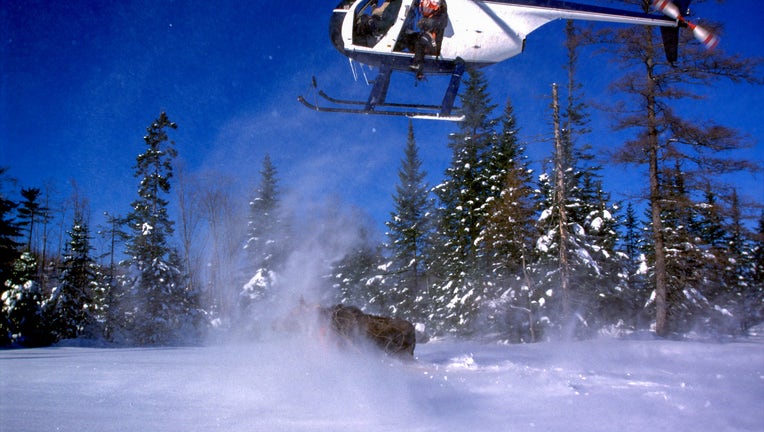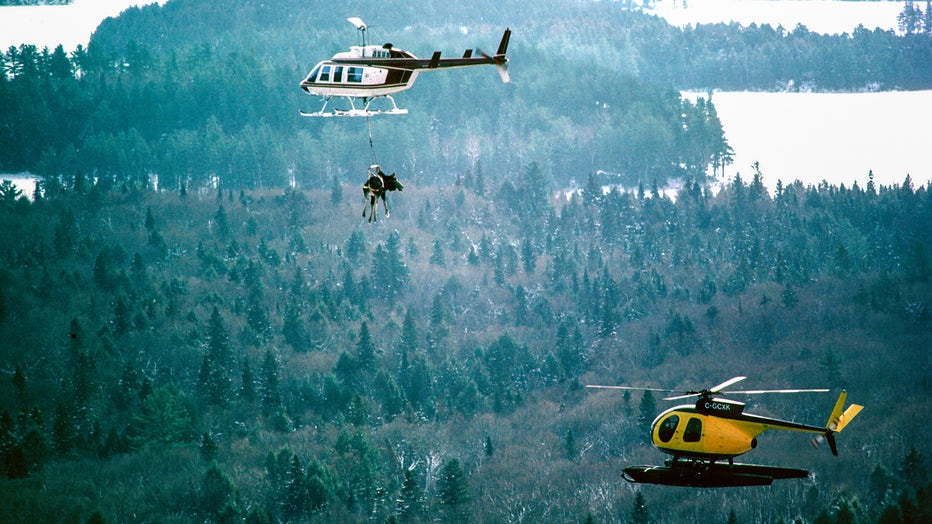Moose study in Michigan UP will collar 60 individuals this February

A helicopter hovers above a moose that has just been netted during previous moose collaring operations. (Photo courtesy of the Michigan Department of Natural Resources.)
(FOX 2) - The Michigan Department of Natural Resources is partaking in a new moose study to better understand the environmental pressures keeping the animal's population from growing, decades after they were reintroduced to the state.
After years of increasing numbers, the growth of moose in Michigan's Upper Peninsula has stagnated. While the mystery around their plateauing figures remains, a collaborative effort up north will hope to find an answer as to why over the next two years.
The backstory:
Forty years ago, a bold reintroduction effort to increase the number of moose in Michigan included airlifting 59 individuals from Canada to Marquette County in the Upper Peninsula.
Dubbed the "Moose Lift," the goal was to help return moose numbers to levels from before European settlement in the 1800s led to their disappearance from the state.
The hope was by 2000, there would be 1,000 moose in the region. Officials have achieved less than half that goal. In 2023, the Department of Natural Resources' aerial survey concluded there were 426 moose in the western UP.
There had been steady growth of 10% between 1997 and 2007. But since then, DNR officials estimate their numbers have only climbed 1% annually.

A moose is transported by a helicopter in Canada during the 1980's Moose Lift operations. (Photo courtesy of the Michigan Department of Natural Resources.)
Big picture view:
The question of why moose numbers aren't climbing now looms over the species.
To find an answer, the Michigan DNR, the Keweenaw Bay Indian Community, and Northern Michigan University are collaborating over the next two years to fit 60 moose with collars.
The study aims to capture and equip 20 moose with radio collars by the end of the first year.
The effort will include using spotter planes from above to point out moose locations to nearby helicopters. From there, officials will sedate the moose, recording their biological information before giving individuals a tracking collar.
The survey will take place across the Michigamme Highlands in mid-to-late February.
Data on migratory habits, pregnancy rates, mortality causes and more will be collected in hopes of testing some hypotheses around their slow population growth.
Scientists theorize low rates of twin calves being born, parasites like brainworm from white-tailed deer, and warmer temperatures as playing a factor.
Dig deeper:
There is no bigger animal that lives in Michigan than the moose, which is a symbol of Great Lakes wildness. They can weigh up to a thousand pounds and stand more than six feet tall.
But their impact on the landscape doesn't stop with symbolism.
According to a showcase of the DNR's new aerial undertaking, moose "shape the structure of forests through their feeding habits, which includes browsing on trees like aspen, birch and balsam fir."
Their relationship on Isle Royale in Lake Superior best underscores this dynamic, but that connection can be found elsewhere in the state.
Their impact on the wild also impacts other species that live there, including deer, birds, insects, and plant life. Some refer to them as a "keystone species" due to their influence.
That makes understanding their low birth rate and slow population growth important to the overall health of the environment.

A moose fitted with a radio collar trots through a snow-covered landscape. (Photo courtesy of the Michigan Department of Natural Resources.)
The Source: Information from a DNR newsletter on the moose study, as well as previous FOX 2 reporting was used in this story.


